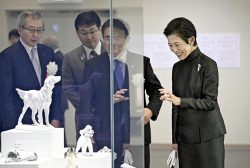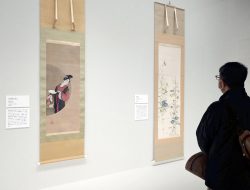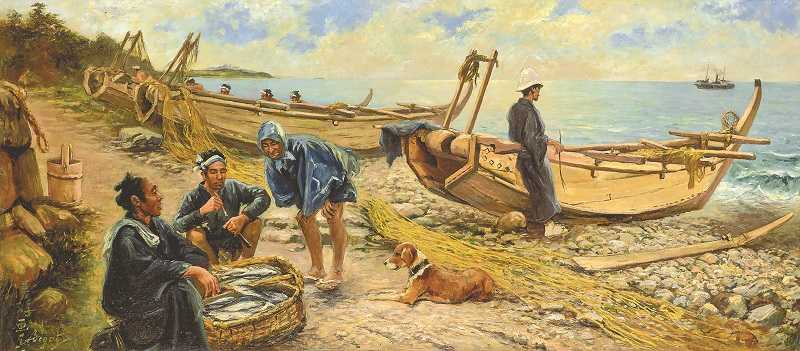
“The Beach at Atami (Japan),” an oil painting by Georges Bigot created around 1888.
12:22 JST, June 10, 2021
The fishermen are pleased with the day’s bountiful catch. Even their dog looks happy. Men in the background powerfully haul a fishing boat onto the beach.
Amid the bustle of the scene, another man stands nearby with his back to the others, looking solitarily out to sea. The strange hat he wears looks like a pith helmet of the kind that Westerners donned when traveling to their colonies in the tropics.
The man is watching a steamboat off in the distance with smoke rising from its funnels. Does he wish he was aboard the vessel? Or maybe he is thinking, “And don’t come back”?
“It’s safe to say the man is Bigot himself,” said Kei Fujiwara, 34, a curator of the Utsunomiya Museum of Art, of the painting by Paris-born artist Georges Bigot (1860-1927).
Bigot arrived in Yokohama in 1882 and lived in Japan for 17 years. The painting called “Atami no Kaigan,” or “The Beach at Atami (Japan),” was the largest oil painting he produced during his stay. Some contend that the work expresses a sense of nostalgia in Bigot. But Fujiwara thinks otherwise.
“It’s highly likely that Bigot sent this painting to the Salon in Paris,” Fujiwara said, referring to the official exhibition of art sponsored by the French government. “I think he created this as a historical piece to show the French people. There was a rich and peaceful life in Japan, a ‘Golden Age’ that no longer existed in the West. But that glow was about to fade. That’s what I think he wanted to express.”
There is no record that the painting won a prize at the Salon. “To the eyes of the judges at the academic Salon, this might have looked like just a mere genre painting about a remote place in Asia,” Fujiwara said.
Beyond the Salon at the time, the Impressionists were starting to make their mark, influenced by Japanese ukiyo-e woodblock prints. Bigot was also swayed by Japonism, and in that sense, could said to have been like a brother of the Impressionists. However, the young Bigot had energy to break the mold. He actively incorporated the real Japan into his art.
The Kaishin Shimbun, a newspaper published during the Meiji era (1868-1912), hired Bigot as an illustrator in 1885 and introduced him as “a self-proclaimed Edokko of France,” using the term for a native of Edo, the old name for Tokyo.
He drew sketches of racy scenes between prostitutes and clients at brothels, while he himself indulged in a life of debauchery. He also launched the satire magazine Tobae in Yokohama as an apparent successor to British artist Charles Wirgman, the publisher of Japan Punch who came to Japan 21 years earlier than Bigot. In Tobae, Bigot’s illustrations harshly depicted Japanese charging ahead to Westernize, much to the displeasure of high-ranking government officials.
To an artist who sought the ideal in good old Edo, the rapid changes in Meiji Japan might have been too much to bear. In 1899, he returned to France with his son, leaving behind his Japanese wife whom he subsequently divorced. Bigot spent his later years living in a village on the outskirts of Paris, where he was seen clad in a kimono. Villagers nicknamed him “Japonais,” meaning a Japanese man.
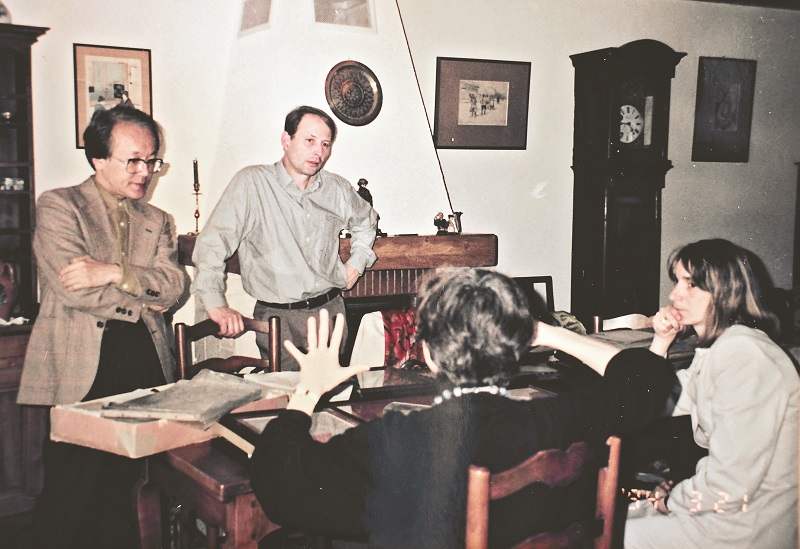
Isao Shimizu, far left, meets Bigot’s descendants in France in 1994.
Longing for Japan
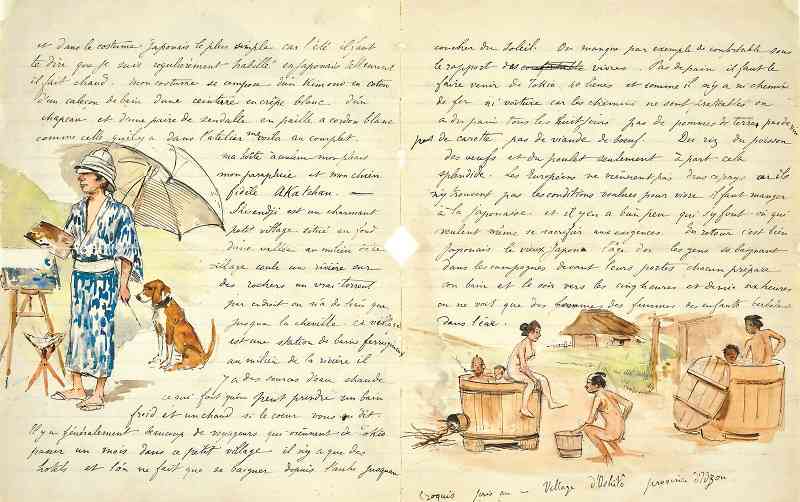
An illustrated letter by Bigot to his mother from Atami, Shizuoka Prefecture, on Aug. 26, 1887
Fast forward to 1970. Bigot had been completely forgotten in France, but a fan in Japan obsessed with his works shed a new light on the maverick artist.
Isao Shimizu, who spent 15 years painstakingly collecting Bigot’s satirical illustrations and sketches, privately published the collection in a limited edition of 500 copies. He included detailed commentary on each work and a timeline of the artist’s life. Titled “Georges Bigot Gashu” (The collected works of Georges Bigot), it was the first truly academic research on Bigot published in the post-World War II era.
At the time, Shimizu was an editor working at a publishing company. Following the Bigot collection, he wrote or edited more than 100 books as the foremost expert on satirical art and manga during the Meiji era.
“My life has been completely fixated on Bigot,” Shimizu said in reflection during a TV interview introducing Bigot recorded late last year. He passed away in March at age 81.
“He’s the type who would spend all he earned on used books,” said his wife, Miake, 76.
In 1994, Shimizu traveled to France to meet Bigot’s descendants, and ended up spending a large sum of his own money to purchase works that had been sitting forgotten in an attic. “I was so surprised and thought, where on Earth did he keep so much money?” Miake recalled when hearing the amount.
Partly due to Shimizu’s efforts, the Utsunomiya Museum of Art holds one of the world’s largest collections of Bigot’s works. The Chiba City Museum of Art also possesses his art, including oil paintings such as “Inage Kaigan” (Inage beach).
Bigot’s satirical drawings are quite harsh on the Japanese. One of the most famous appeared in the sixth issue of Tobae in 1887. A well-heeled couple stands in front of a mirror as they prepare for a ball in formal attire, but their reflections show monkeys.
“I saw that drawing in a textbook when I was in high school, and I remember becoming furious,” said Ayumi Ueda, 34, who is researching Bigot at Hitotsubashi University’s graduate school. “When I was a child, I lived in France because of my father’s work, so I learned what it feels to be looked at as a foreigner. I was shocked [by the drawing] because I thought, ‘Maybe this is how I looked in the eyes of the French.’”
Ueda now believes that Bigot had no intention of showing racial discrimination. “He drew those satirical pictures for a living,” she said. “I think he caricatured the Japan that the French wanted to see in a funny, outlandish way.”
Attesting to that view are Bigot’s works of people and landscapes in Japan that he painted after returning to France. None of the Japanese are depicted in a grossly unattractive way. In fact, some even suggest a pure longing for Japan.
“Bigot was a pacifist who hated conflict. I think he saw the beauty of pre-Westernized Japan in the women rather than the men. I have a feeling that he probably wished that Japanese women in kimono would stay that way forever,” Ueda said.
"Culture" POPULAR ARTICLE
-
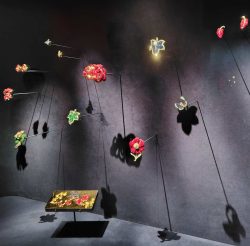
Van Cleef & Arpels Dazzles with Art Deco Artisanry at Tokyo Exhibit
-

Disney’s ‘Twisted-Wonderland’ Animated Series Puts Villains in Spotlight: New Show Features School Inspired by Classic Disney Films
-

Japan Plans to Distribute Manga Overseas Via New Platform
-

Japanese Craftsman Produces Beautiful and Durable Bags Made of Wood
-

Ayumi Hamasaki’s Shanghai Concert Canceled Day Before Schedule as Part of Beijing Backlash
JN ACCESS RANKING
-

Keidanren Chairman Yoshinobu Tsutsui Visits Kashiwazaki-Kariwa Nuclear Power Plant; Inspects New Emergency Safety System
-

Imports of Rare Earths from China Facing Delays, May Be Caused by Deterioration of Japan-China Relations
-

University of Tokyo Professor Discusses Japanese Economic Security in Interview Ahead of Forum
-

Japan Pulls out of Vietnam Nuclear Project, Complicating Hanoi’s Power Plans
-

Govt Aims to Expand NISA Program Lineup, Abolish Age Restriction



